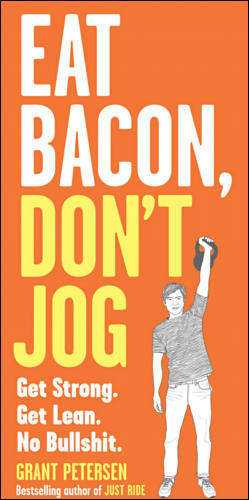
It allows to keep PV going, with more focus towards AI, but keeping be one of the few truly independent places.
-

 sample949.jpg249 x 500 - 31K
sample949.jpg249 x 500 - 31K -
Humans have bigger brains than wild animals, and when it comes to exercise, that may be part of the problem: We combine facts and falsehoods in ways that animals can’t, and come up with crazy ideas about exercise. There’s no animal equivalent to the human jog, and before the moon landing, jogging was a fairly freakish behavior, even for us. Then in 1968, Kenneth Cooper’s bestselling book Aerobics triggered the overexercising boom, and all we’ve gotten is more tired, injured, and fatter. Watch any public half or full marathon, and you’ll see desperate people suffering long hours of ineffective, even dangerous, exercise.
We’re so used to the idea of suffering being productive—studying for a test, scrubbing road rash, swallowing foul-tasting medicine—that even when it’s not healthy, we think it is. Jogging feels healthy because it’s dreadful, but it’s the kind of dreadful that’s counterproductive. Your body responds to too much running by releasing cortisol, a stress hormone. Cortisol triggers a process called gluconeogenesis, in which your muscles (made up of protein) break down into glucose. A lifestyle that includes hours of running every week can grind down your muscle, which causes the gaunt, wiry look of so many world-class marathon runners. The healthiest and arguably best-looking bodies in the sports world belong to sprinters, gymnasts, rock climbers, and dancers. They may have good genetics, but it is short, intense, straining, gasp-inducing exercise that shapes their bodies. They don’t jog.
Jogging doesn’t build strength or fitness—it just trains muscles to tolerate more jogging, and in the real world that’s close to useless. You don’t jog to a bus that’s about to take off, or jog away from bad guys who are chasing you on foot. You sprint. Nobody ever jogged for a touchdown, or down the basketball court on a fast break, or across the tennis court to return a shot.
Jogging’s reputation for being healthy doesn’t jibe with reality. Do it if it’s the way you like to wind down or relax, but don’t do it for your physical health.
Short, intense exercise that makes your muscles burn and makes you gasp for more air to supply the burning muscles with oxygen. It has to be hard. If you can talk or watch TV or maintain the effort level for more than 5 minutes, it’s too easy. If you want maximum return on your exercising minutes—so you can make it as short as possible—you need to work as hard as you can.
This idea is antithetical to the “exercise is fun” notion that drives the exercise industry, but let me be clear about this. Skiing, hiking, riding a bike, and surfing are fun, but the exercise is incidental to the fun. Fun is great, but it’s an inefficient way to get fit. I’m not saying don’t do it—that stuff can be the best part of your life. I’m just saying that when the goal is improved cardiovascularity, stronger muscles, and injury resistance, then short, superintense exercise works much better and much faster than play or recreation. Maximally efficient exercise is barely bearable, and not even close to fun.
Your efficient time exercising can be as short as 3 to 7 minutes a day. Seven minutes is only about 1/200th of your day. When you’re finished, you won’t feel wasted like you do after a long ride or run. You’ll fully recover in a few minutes and have the rest of the day to work, play, travel, explore, study, read, have sex, ride your bike, hike, and walk the dog. Short, intense workouts make your fun exercise easier and leave more time for life.
Workout clothing is half unnecessary, half scam. If you already own grippy shoes that flex, and loose or stretchy pants, you have plenty of workout clothing already. Anything that allows squats and jumping jacks is fine for a 3- to 7-minute workout. You’ll be finished with your workout in the time it takes to change costume, and with the workouts so short, you won’t sweat and stink up whatever you’re wearing. The jeans you chop wood in, the T-shirt you would never wear in public, the linen slacks that are not too tight, the blouse that makes you look ten years older and 20 pounds heavier—they’re all perfect. Shoes are easy, too: Wear flat or low-heeled shoes or sandals, nothing with raised heels that pitch you forward. Or go barefoot. If a new workout wardrobe supercharges your motivation, then go to town—but spend twice as much on kettlebells.
If you’ve spent years trying to work off your fat to no avail, here’s a way. Understanding this will help you to stop trying to do something that is truly impossible and beating yourself up for failing at it.
Most doctors, nutritionists, and the government still say weight management is simply a matter of burning more calories than you eat. They’re the Flat Earthers, the Continental Drifters, the Creationists of weight management. What they say—that eating less and exercising more is a sustainable way to lose weight—ignores the effects of insulin. Weight gain or loss is all about insulin. Any discussion of calories eaten versus calories burned must include insulin’s role in determining whether you burn sugar or fat, and something called homeostasis.
Homeostasis is your body’s way of balancing input and output, and keeping you alive without your having to think about it: shivering to stay warm or sweating to cool down. When shivering alone won’t warm you up, your desire to stay comfortable makes you put on a coat; and when it’s hot out, it makes you strip off layers. When your body needs help keeping you comfortable, homeostasis calls you to action.
In eating and exercising, homeostasis trumps willpower and determination. Consider this: There are 3,500 calories in a pound of fat, whether the fat comes from a salmon, a pig, a pile of soybeans, or your belly. An hour of strenuous exercise burns 700 to 900 calories, depending on how big you are and how much you’re able to suffer. But let’s use the 700-calorie figure for now, because it’s an effort level most people can sustain if they’re forced to suffer for an hour in a jog.
To lose 1 pound mathematically, you have to exercise (at 700 calories per hour) for 5 hours, while consuming zero calories. The problem is that exercise makes you hungry, and when you’re burning glucose—because you’ve not yet trained your body to burn its own fat for energy—you won’t be able to exercise for more than 2 or 3 hours without requiring more glucose—supplied by more carbs. For every 700 calories of carbs you eat, you have to exercise another hour to stay on track for the 3,500 calories you need to burn off a pound of fat. That extra hour of exercise, in turn, is another hour spent working up an appetite.
If you survive a 5- to 7-hour jog and burn up 3,500 calories, you’ll be starving in a few hours and will eat them back on, because homeostasis insists on a balance of output and input. Willpower has nothing to do with it. Your body will get back those lost calories, and your long jog will have been for nothing.
So if you’ve been jogging for the sole purpose of burning calories, you now have a scientific basis for knocking it off. Exercise tones muscles and keeps the blood flowing, calms you down, flushes you out, maybe even jacks up your endorphins. It is a good thing for many reasons, but weight loss isn’t one of them. So enjoy your hikes, walks, rows, bike rides, and swims without any regard for the calories they burn up.
-
That is what I've been doing. I purchased a nordic track for 25 dollars off craigslist and have wavered between atkins ketogenic and a moderate-to-low carb/sugar diet. A couple years ago I was doing sprints instead, but I got prostate spasms due to it, and had to get a whole host of medical evaluation done as a result.
I do three or four minute runs on the nordic track maybe three times a day.. it gets the heart rate racing for about 5 minutes. After that I'm done.. I dropped in weight real quick. The challenge is to keep up with it.
Jogging fitness is a requirement for some law enforcement agencies though, so one might not be able to avoid the jogging completely
-
You can also try kick scooter for extremely low traumatic and not risky but high intensity exercises.
-

More than 100 million U.S. adults are now living with diabetes or prediabetes,
https://www.cdc.gov/media/releases/2017/p0718-diabetes-report.html

 sample952.jpg478 x 326 - 34K
sample952.jpg478 x 326 - 34K
Howdy, Stranger!
It looks like you're new here. If you want to get involved, click one of these buttons!
Categories
- Topics List23,992
- Blog5,725
- General and News1,355
- Hacks and Patches1,153
- ↳ Top Settings33
- ↳ Beginners256
- ↳ Archives402
- ↳ Hacks News and Development56
- Cameras2,367
- ↳ Panasonic995
- ↳ Canon118
- ↳ Sony156
- ↳ Nikon96
- ↳ Pentax and Samsung70
- ↳ Olympus and Fujifilm101
- ↳ Compacts and Camcorders300
- ↳ Smartphones for video97
- ↳ Pro Video Cameras191
- ↳ BlackMagic and other raw cameras116
- Skill1,960
- ↳ Business and distribution66
- ↳ Preparation, scripts and legal38
- ↳ Art149
- ↳ Import, Convert, Exporting291
- ↳ Editors191
- ↳ Effects and stunts115
- ↳ Color grading197
- ↳ Sound and Music280
- ↳ Lighting96
- ↳ Software and storage tips266
- Gear5,420
- ↳ Filters, Adapters, Matte boxes344
- ↳ Lenses1,582
- ↳ Follow focus and gears93
- ↳ Sound499
- ↳ Lighting gear314
- ↳ Camera movement230
- ↳ Gimbals and copters302
- ↳ Rigs and related stuff273
- ↳ Power solutions83
- ↳ Monitors and viewfinders340
- ↳ Tripods and fluid heads139
- ↳ Storage286
- ↳ Computers and studio gear560
- ↳ VR and 3D248
- Showcase1,859
- Marketplace2,834
- Offtopic1,319





